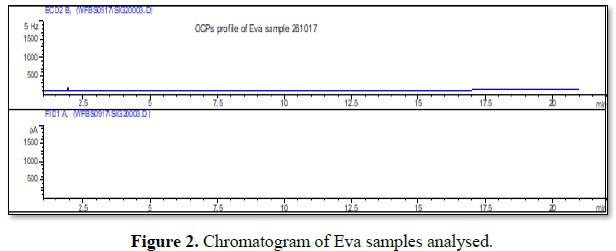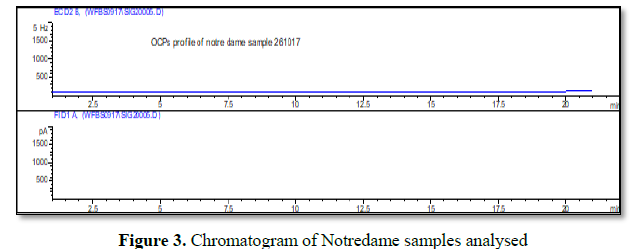594
Views & Citations10
Likes & Shares
This research studied the levels and risk assessment of pesticide residues in selected potable water supply such as Eva and Notredame water commonly sold in Benin City markets. A total of twenty-five organochlorine pesticide (OCP) residues in these samples were analyzed using with gas chromatography- electron captured detector (ECD).The estimated mean of organochlorine pesticide concentration in potable water (Eva and Notredame) was determined based on European union (EU) and United States Agency of Toxic Substances and Disease Registry (ATSDR) standards. The results revealed the levels of organochlorine pesticide residues among the potable water (Eva and Notredame) which were below detection limit (0.00 ± 0.00). The study, thus suggest that OCPs concentration in Eva and Notredame water are safe for human but could require continuous surveillance. The study therefore calls for continuous sensitization to farmers from the use of these dreaded chemicals, that could contaminate underground water and periodic investigation of potable water (Eva and Notredame) sold in Benin City markets.
INTRODUCTION
There has been an alarming rate about ingestion of pesticide residues by adults and children who consume potable water. Consumption of potable water has increased over time because it is inestimable. Xenobiotics are major cause for concern all over the world, given their persistence to their metabolite residues after degradation by artificial or natural means and negative effects on humans [2].
In 2001, about 74 percent of potable water sold in the United States of America (USA) was reported to contain atleast one pesticide residue greater than the acceptable level [3]. This increase in level of pesticide residues has risen in developing countries and the fastest growing markets in Africa, Asia, South and Central America, Eastern Mediterranean [3].
The toxic effects of these pesticides have caused them to be banned in developed and many growing nations. Moreover, some growing countries still use them [4].
The aim of this study was to assess the level of organochlorine pesticide residues in potable water (Eva and Notredame) sold in markets in Benin City.
MATERIALS AND METHOD
Study area
Benin City has a lot of super markets located in different localities in the city where potable water (Eva and Notredame) are sold for final consumption. The markets include Ekiosa, New Benin, Oba market, Ikpoba hill market and Uselu market. The potable water (Eva and Notredame) are usually transported from within the state or other neighboring western, eastern, southern or northern part of the country.
Sample collection
Random sampling of potable water; Eva and Notredame were purchased from the various markets in Benin City. However, samples were provided to the analytical laboratory for GC analysis [6].
Sample extraction
• Prepare a solvent 50:50 mix of Acetone and n-Hexane or DCM and Acetone.
• Measure about 30gram aliquot of well mixed sample into a solvent rinsed beaker.
• Add 1mL of Decachlorobiphenyl, mix thoroughly using glass stir rod.
• Weigh an equal amount of Sodium Sulfate and add to the sample and mix thoroughly to form a free flowing powder.
• Add 50 ml of the solvent mix to the samples.
• Place sample in the Sonicator and Sonicate for about 10-15 min at about 60°C.
• Decant the extract into a round bottom flask.
• Repeat once more with an additional 50 ml of solvent mix, Sonicate and allow the beaker to settle and decant into the same round bottom flask.
• Concentrate the sample extract using Rotary Evaporator, to 1-2 mL
• Add about 5 mL Hexane to the extract
• Evaporate it to reduce the volume to 1-2 mL.
• Make the final volume 2 mL in Hexane, giving final sample weight of 15 g/mL.
• The sample is ready for sulfuric acid/permanganate cleanup/gel permeation chromatography [6].
Sample clean-up
• Using a syringe or a volumetric pipette, transfer 1 or 2 mL of the hexane extract into a 10 mL vial in a fume cupboard.
• Carefully add 5 mL of the 1:1 Sulfuric acid: water mixture, ensure there is no exothermic reaction.
• Cap the cap tightly and vortex for 1-2 min.
• Allow the phases to separate for at least 3 min, observe the upper hexane layer and ensure that it is not highly colored.
• If the upper layer is colored or the emulsion persist, discard the sulfuric acid layer using pipette and add fresh 5 mL sulfuric acid/water mixture.
• Cap tightly and vortex as above.
• Allow the Phases to separate by allowing standing for 2 to 3 min.
• If the upper layer is clear, transfer the Hexane layer using a glass pipette into the 10 mL vial.
• Add 1 mL of n-Hexane to the sulfuric acid layer and repeat the vortex procedure.
• Allow the phases to separate, transfer the n-Hexane layer into the 10 mL vial.
• Take care not to include the acid layer into the 10 mL vial as it could damage the column and instrument [6].
Permanganate clean-up
This cleanup procedure is employed when the sulfuric acid cleanup could not remove all the color from the sample extract.
• Add 5 mL of 5% permanganate to the combined n-hexane extract above in the hood.
• Ensure there is no exothermic reaction; cap the vial and vortex for 1 min.
• Allow the two phases to separate, if a clean separation is achieved, transfer the hexane layer into a clean 10 mL vial.
• Add additional 1 mL hexane to the permanganate layer.
• Cap the vial and vortex for 1 min.
• Allow the phase to separate, and transfer the hexane to the 10 mL vial using a glass pipette.
• Reduce the combined hexane extract volume to the initial 1-2 mL using the appropriate method.
Silica gel clean-up
Reduce the extract volume to 2 mL and the extract solvent should be hexane:
• Mount the clean polypropylene cartridge on a manifold or stand.
• Block the base with sterile cotton wool or glass wool, whichever is available.
• Add 2 g of the activated silica gel to the cartridge and tap the wall of the cartridge for good packing.
• Add a layer of dry Na2SO4 to the top of the column.
• Condition the column with about 15 mL of n-Hexane, collect the eluate to waste.
• Do not allow the column to dry up at this stage.
• Transfer the 2 mL extract to the head of the column with the help of a pipette.
• Elute the column with 15-20 mL hexane; collect the fraction in a clean 50 mL glass beaker. This fraction contains all the OCPs.
• Dry the sample extract using the appropriate technique.
• Make up the dry extract with 2 mL n-Hexane and transfer into a GC vials. Sample extract is ready for GC analysis [6].
Calculation for sample analysis
The concentration of each analyte range in a sample was calculated directly from the Instrument using the Data Analysis Software. The final sample weight and the dilution factor can be used in the batch file and the final results would be generated by the software.
The use of the Response Factor Method could be employed [7].
Cf = Area (p) × Rf × Vf × Df × 1000
Wi
Where:
Cf=Final Sample concentration (mg/L)
Area (p)=Measured area of peak (peaks)
Wi=Initial weight extracted (g dry weight)
Vf=Final extract volume (mL)
Df=Dilution factor of sample or extract if diluted
RF=Response factor from the calibration standard calculation
RF= Concentration (P)
Area (P)
Concentration (p)=Concentration of peak or Total concentration of range
Area=Area of peak or total across range
RESULTS AND DISCUSSION
The chromatogram result in this study is in consonance with that of Food and Drug Administration [1] who assessed potable water in Addo Ekitti, Ogun and Benin. Reports from this investigation reveal that Organochlorine pesticide residues were below detection limit (BL) (0.00 ± 0.00) in Table 1.
Twenty five pesticides were assessed in potable water (Table 1) and all were below detection limit (0.00 ± 0.00) for both samples (Eva and Notredame).
Although organochlorine pesticide residues concentration in potable water (Eva and Notredame) in this study were below detection limit, it could be attributed to mild application by farmers for the control of pest. This is because of their potency, efficiency and low cost compared with alternative pesticides (banned or not) [2].
These dreaded organochlorine pesticides get into underground water via; (lack of awareness, inappropriate use of pesticides, waste from industrial chemical production, pesticides runoff from agricultural areas, sewage and refuse dump) [8]. The findings in this study is in consonance with the findings of Fianko et al. [4] observed that organochlorine pesticide residue in potable water ranged from 0.000 to 0.00 mg/kg in Benin City, Addo Ekitti, Ogun, Lagos and Ghana, respectively.
Previous studies have demonstrated that organochlorine pesticides are harmful and can affect non target organisms other than the organisms of interest, thereby causing great chaos to ecosystem and to consumers [5].
The use of organochlorine pesticides for the control of pest by farmers is a global phenomenon. These compounds are characterized by high persistent, low polarity, low aqueous solubility and high lipid solubility (lipophilicity). They are ecotoxic, non-biodegrable and able to bioaccumulate and biomagnify in living organisms [4]. The major problems are their deleterious effects such as ability to cause cardiovascular disease, asthma and other diseases of public health concern.
Organochlorine pesticide residues at any given concentration are highly toxic, bioaccumulate and not readily biodegraded [8].
CONCLUSION
1. Food and Drug Administration (1999) Pesticide Analytical Manual. Volume I: Multi residue Methods, 3rd Edn, U.S. Department of Health and Human Services, Washington, DC.
2. Daam MA, van der Brink PJ (2010) Implications of differences between temperate and tropical freshwater ecosystems for the ecological risk assessment of pesticides. Rev Ecotoxicol 19: 24-37.
3. Gilden RC, Huffling K, Sattler B (2010) Pesticides and health risks. JOGNN 39: 103-110.
4. Fianko J, Donkor A, Lowor S, Yeboah P, Glover E, et al. (2011) Health risk associated with pesticide contamination of fish and fruits vegetables from the Densu River Basin in Ghana. J Environ Protect 3: 125-154.
5. Papadakis E, Zisisvryzas AK, Katerina K, Konstantinos M, Papadopoulou-Mourkidou E (2015) A pesticide monitoring survey in rivers and lakes of northern Greece and its human and ecotoxicological risk assessment. Ecotoxicol Environ Saf 124: 1-15.
6. Anastassiades M, Lehotay SJ, Štajnbaher D, Schenck FJ (2003) Fast and easy multi residue method employing acetonitrile extraction/partitioning and “dispersive solid phase extraction” for the determination of pesticide residues in produce. J AOAC Int 86: 412-431.
7. Renwick AG (2002) Pesticide residue analysis and its relationship to hazard characterization (ADI/ARfD) and intake estimations (NEDI/NESTI). Pest Manag Sci 58: 1073-1082.
8. Fernndez-Alba AR, Garca-Reyes JF (2008) Large-scale multi-residue methods for pesticides and their degradation products in food by advanced LC-MS. TrAC Trends Anal Chem 27: 973-990.




